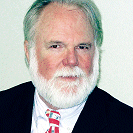The CIO: Earning Your Seat
 TAKING A PLACE AT
THE PRESIDENT’S
TABLE MAY BE
HELPFUL, EVEN
CRITICAL, TO
A CHIEF INFORMATION
OFFICER’S SUCCESS.
BUT DON’T OVERLOOK
OTHER FACTORS
BEHIND THE CURRENT
EMERGENCE OF THIS
NEW, COLLABORATIVE,
PAN-CAMPUS LEADER,
SAY CIOS IN THE KNOW.
TAKING A PLACE AT
THE PRESIDENT’S
TABLE MAY BE
HELPFUL, EVEN
CRITICAL, TO
A CHIEF INFORMATION
OFFICER’S SUCCESS.
BUT DON’T OVERLOOK
OTHER FACTORS
BEHIND THE CURRENT
EMERGENCE OF THIS
NEW, COLLABORATIVE,
PAN-CAMPUS LEADER,
SAY CIOS IN THE KNOW.
We are past the point where IT
needs to be “run.” The IT department has become so enmeshed in
the interests and activities of the entire institution that, these days,
IT requires a good deal more than an overseer. While the executive
charged with leading IT is often called the chief information
officer, chief information leader would now be a much better title.
And that’s because leaders can envision where we need to go and
how to get there. They get everyone on board for the trip, and they
solve problems that seem about to ruin the journey. They also
make sure that the tank is filled with gas and the motor tuned so
that nobody else even has to think about those things.
The “journey,” as it is, is toward a better, stronger, more flourishing
institution. The obstacles that litter the route include
scarce funding, enrollment worries, more demanding regulations,
assaults by network worms and lawsuits, and the increasing
cost of just about everything that makes an institution great.
In the profiles that follow, successful CIOs from institutions
of different sizes and distinctive cultures talk about how they
live up to the challenges of their office, passing on some of the
lessons they have learned.

Karin Steinbrenner, UNC
Steinbrenner is associate
provost for Information
Systems and CIO,
University of North
Carolina-Charlotte, a
research-intensive university
and the fourth
largest of the 16 institutions
within the University
of North Carolina System.
Steinbrenner reports to the provost.
When a new chancellor came to UNCC,
one of his first acts was to restructure
the executive council to include the
CIO, says Steinbrenner. So she knows
what it is like to be a CIO with—and
without—a seat at the planning table.
Here are her thoughts:
The Role of the CIO.“It is a necessity
for the CIO to be part of the executive
team; IT supports every single function
at the university. If one of the divisions
plans an initiative involving IT, one has
to consider how that may affect the existing
IT infrastructure: Are there solutions
already out there to support this? Can we
build on an existing solution?
“IT’s role is changing from supporting
the business, to having an influence
on how we do business. For example, IT
can facilitate growth without a proportional
increase in staffing if, for
instance, we reach out to students
through distance learning and hybrid
learning. If a class meets one time in person
during the week and twice virtually,
then the institution has saved two-thirds
of [the available] classroom space.”
Building relationships. “I am constantly
struggling with the optimal organizational
structure in order to reach out
to all levels of the institution. For example,
our Web services team has its own
constituent group throughout the campus
that it collaborates with. Likewise,
there are staff in all colleges who are
involved in eLearning. So, IT has to
work collaboratively with everyone,
including areas like Student Life and
Physical Security. New suborganizations
that are horizontal are always emerging.
I am constantly struggling with the
optimal organizational structure in
order to reach out to all levels of the
institution.
—
—Karin Steinbrenner, UNCC“Horizontal collaboration can be
effective, but sitting at the table will
make that work better. One can have
federated arrangements and a governance
policy that says, ‘This is how
decisions are made; this is how we collaborate.’
But if there is no enforcement
or even encouragement from the top,
then when one department d'esn’t like
the de facto standard campus solution, it
all falls apart. “The bigger the institution
gets, the more difficult it will be to
be effective without presence in the top
management.”
Tips for CIOs. “Don’t alienate the
academics. You can do a fantastic job,
implement portals and ERPs, and protect
the campus from spam and viruses, but if
the faculty is not on your side, forget it.
“Put a good governance structure in
place. Create a good organizational structure
for IT. Communicate to the campus
what IT is responsible for, and get
approval of that from the executive team.
“Work on the foundation to make sure
that you are delivering excellent services
before you move to the next stage.
You don’t want to constantly work on
the 90 percent of IT that is invisible.
You want to have high-level projects
that are visible to campus, but on the
other hand, don’t allow day-to-day functions
to become a liability for the sake
of implementing a flashy project.
“Understand the budget. Be an advocate
for what you really need to run the IT
organization (including training, replacement,
and maintenance) so that you don’t
constantly rob Peter to pay Paul.
“Win the trust of the president and the
other senior staff. The university is full of
IT experts giving conflicting advice; but
the leaders have to listen to the CIO.”

Mike Yohe, Valaparaiso
Yohe is executive director of Electronic
Information Services at Valparaiso University (IN), a Lutheran-affiliated institution
with an enrollment of 4,000
students in its liberal arts and professional
programs, including a graduate division
and law school. He reports to the
provost, who at Valparaiso is both the
chief academic officer and the chief operating
officer. Yohe has been at Valparaiso
for 10 years and, prior to this post, headed
IT at three other institutions.
Every Friday, I write a newsletter about what is
going right, what is going wrong, what is coming
up next week, or what is on the horizon. Even the
student newspaper occasionally picks up items
from it.
—
—Mike Yohe, ValparaisoLeading IT in a close-knit institution.
“I do not sit on the president’s council.
Given the environment at Valparaiso, I
don’t think that makes a lot of difference,
because there is so much conversation
back and forth. And it is not that I am
excluded at all from the processes, I just
don’t sit at the table. Occasionally, there
are things that might have gotten clarified
a little sooner, and in that case, there
would be some usefulness in being on the
president’s council to provide understanding
at a meeting rather than straightening
things out afterwards.
Getting a collaborative project done.
“When I came to Valparaiso, the president
told me that the number one priority
was to change the administrative
system. I was fortunate that the registrar
had been here a long time, and was a
highly respected and loved person on
campus. She teamed up with me to cochair
the process. She was the ‘people
person’ and I was the techie.
“We got the stakeholders together,
started the RFP [request for proposal]
process, and used that RFP as a consensus-
building instrument as much as a
definition of what we wanted from the
vendor.”
Taking part in the budget process. “I
don’t think IT would get a different
share of the university budget if I sat on
the president’s council. Most institutions
are operating on a lean basis.
While IT d'esn’t get all the money that
we believe we need, from the standpoint
of what is available, I actually think the
university is on target with what it gives
us. We have to stretch dollars and make
equipment run longer, just like everybody
else, but I don’t feel shortchanged.
“IT’s effect on the budget process
probably depends on the culture of the
institution. I have tried to keep the
whole picture in view, not just IT. If
your colleagues see that you are concerned
about the mission of the whole
institution, not focused parochially, then
they give you more credence when you
ask for something.”
Managing the burden of communication.
“When things are going wrong, it’s
a good idea to get out there and say, ‘I
know this isn’t good. Here is what we are
doing to fix it, and this is about how long
it is going to take.’ People need to know
what progress you are making in solving
problems. But most of us are stretched
pretty thin. If you stop and give progress
reports as often as people want, you won’t
get anything done with the problem. It is
more than a balancing act—you have to
keep from falling off the tightrope.
“Every Friday, I write a newsletter
that is sent to a campus subscriber list,
saying what is going right, what is going
wrong, what is coming up next week, or
what is on the horizon. I throw in a few
things about how to manage a PC, or
other tips. It runs a couple of typed
pages, and it’s written so that busy people
can skim through it, find things they
are interested in, and learn about places
to get more information. It has my
‘voice’ and my return address. Even the
student newspaper occasionally picks up
items from my newsletter. It also has
turned out to be a good way for me to
keep in touch with what is going on in
my own organization.”
Tips for CIOs. “Be a good listener.
People need to understand that their work
is important to you. It’s all about serving
the needs of your community. In order to
serve those needs, you have to help identify
them.
“Keep the big picture. Sometimes
technical people can lose the big picture
and get the sense that the university is
here for their convenience. You have to
keep widening their perspective.
“You have to be tuned in to the culture
of where you are. It has to fit you; if you
can’t tune in, move on.”

Robert Paterson, Salem State
Paterson is CIO at Massachusetts’ Salem
State College. (The 150-year-old institution
enrolls over 9,800 full- and part-time
students.) Paterson has served as the head
of technology at four institutions during
his career, and has been at Salem State for
eight years. He is known to many higher
ed IT execs as one of the organizers of the
annual Educause
pre-conference workshop for CIOs.
Constructing a CIO position from
the ground up. “I was the first CIO
hired at Salem State. The president had
bought into the concept that we urgently
needed a new administrative system,
but was not comfortable leading in the
technology area. I recruited one of the
vice presidents into the role of co-leading
the ERP project. The VP for Student Life had a lot of respect from everybody
and was good at working with people;
in fact, he is now the executive vice
president. We built a good working relationship.
At first, though, he was reluctant
to take a leadership role in the
project because he was not ‘into’ technology.
I convinced him that the project
could not be successful if it was run
from a solely technical point of view. He
had responsibility for financial aid and
admissions, and those areas were going
to be key. We set up a structure at the
senior level. We decided: If people really
don’t like what we are doing, they can
appeal to the president.”
The CIO’s role at the table. “Having
me at that table, being one of the senior
folks, gives a different footing and allows
a different kind of conversation to go on.
I saw an ad for a CIO position reporting to
both the academic and administrative
vice presidents, and I shook my head and
said, ‘That is going to be tough.’
“IT deals with foundational things on
which we’re building the institution.
You need a structure that crosses all
areas. People may say, ‘The CIO isn’t
really interested in topics that get discussed
at the president’s council, like
admissions.’ But I am! There is always a
technology hook in any topic like that.
Actually, I try to keep the executive
group from straying too much into the
nuts and bolts of technology; they need
to talk about the process and what they
want to achieve. Leave it to us to figure
out how to do it.
“I believe you are at a disadvantage if
you are not really the CIO. I’m not saying
that there are not people who can pull it
off, but the folks I know who are not sitting
in at the top level seem to have a
more difficult time. A lot has to do with
personalities, who is at the table representing
you, and what issues are distracting
them from supporting you.”
Tips for CIOs. “First and foremost,
you have to be able to communicate.
Technology is only third or fourth on the
list of things you need to know. Develop
ways to explain things non-technically.
Make use of metaphors.
“Understand your organization, how it
works, and how to get that understanding.
“Pick your battles. Initially, do things
the way somebody wants them, then work
on getting it right over time.
“Remember that you can do it quick,
cheap, [or] right: Pick any two.”

Mihir Chatterji, Eastern Illinois
“Chat” Chatterji has been assistant VP for
IT Services at Eastern Illinois University
since October 2002. EIU has an enrollment
of 11,500 students, and offers
undergraduate, graduate, and professional
programs, including colleges of business
and education. Chatterji previously
served as CIO for Ivy Tech Community
College in Indianapolis, responsible for
its 23 Indiana locations.
The policy role of the CIO. “Many of
us came up through the ranks at a time
when the senior-most person in technology
was the director of the computer center.
That person spent most of the time
being in charge of the glass house, running
the mainframe, but all that has
changed. The role of directing the computing
center has shifted to one of being
responsible for infrastructure and policies
that affect the whole campus.
“The structure at Eastern is still a traditional
one, however. I report to the VP for
Business Affairs. And though it has
become more the norm for the CIO to be
at the vice presidents’ table, that hasn’t
quite happened here yet. Maybe the next
CIO will be hired as a VP.”
New issues promote centralization. “Whether structural change is needed is
an individual university choice. But what
the president and the provost have to pay attention to is that all the aspects of computing
that were decentralized in the
past, by the ubiquity of it all, are now
forced into a centralized thought process.
Issues such as privacy, HIPAA and
FERPA, Napster, technology fees, and
wireless access force the director of computing,
if not formally a CIO, to be
viewed more as a CIO—to find ourselves
at the president’s conference table. We
are drawn more into things that affect the
whole campus community.”
Help for the Emerging CIO
- “New Beginnings: Techniques and
Methods for Succeeding as a Senior IT
Leader.” The title of this Educause pre-conference workshop
changes each year, but the content
is always aimed at equipping new CIOs
(or similar positions) with the skills and
strategies for success. The 2005 speakers
included Robert Paterson, CIO,
Salem State College; John E. Bucher,
chief technology officer, Oberlin College (OH); Thomas F. Moberg, VP & CIO, North
Dakota State University; and H. David
Todd, CIO, University of Vermont.
- Educause CIO Constituent Group. There
is no better place to rub shoulders with
working CIOs actively facing the challenges
of leading IT on their campuses.
Topics include: the role of the CIO,
financing and funding strategies, planning
and organizing for information
resources (especially IT), human
resource issues, policies for the networked
information environment, and
the future of higher ed. This group meets
at the Educause annual conference and
uses the electronic discussion list to
mull over issues throughout the year. The
group and electronic discussion list are
moderated by Scott E. Siddall, assistant
provost for Instructional Resources,
director of Instructional Technology,
Denison University (OH).
- The Edutech Report. This newsletter,
aimed at faculty and administrators,
often deals with issues of IT leadership.
The March issue, for instance, carries a
story by Linda Fleit, president of Edutech
International,
about the individual who is an excellent
technologist, but is unable to break
through to upper career levels. To subscribe:
Click HERE.
Moving away from geekism. “Not
much of the CIO’s job is technological
anymore. Most of us got here by being
geeks. Now we find ourselves being
detached from geekism by necessity. I
have dealt with it by hiring really good
people around me to delegate the technology
issues to, so I can concentrate on the
policy issues. In fact, what’s most important
to me now is the people I hire. You
can’t make mistakes there, or else the
infrastructure that you are responsible for
breaks and the policy issues get put aside
while you fix the network.”
Second management layer is emerging.
“There is another planning level
developing—the non-VPs, who are
forced to cooperate in new ways.
Because of issues that cut across boundaries,
you find yourself cooperating with
people who you didn’t have much to do
with before. For instance, Eastern is considering
a universal laptop requirement
for students. That involves the deans and
department chairs, the bookstore, Business
Affairs, and the Purchasing department.
And it could change the whole way
we provide computing infrastructure
through computer labs, and how we support
students through the Center for Academic
Technology Support. It affects the
whole campus, but it all started with
some of us at lunch, saying that we ought
to have something in place for students
that involves laptops and the standard
Microsoft Office suite; that we ought to
think about a universal campus standard.
Projects like this have become less
departmentalized, more cooperative. We
work out a solution among ourselves and
then move it up to the vice presidents’
level to be blessed.”
ISSUES THAT BRING
THE CIO TO THE TABLE
Some IT issues are too big for the technology head to handle
alone, but also too technological for the institution to face without
the CIO taking a leadership role. Here are some examples of current, widespread issues
that point strongly in the direction of including the CIO in the top levels of management.
- INTELLECTUAL PROPERTY MANAGEMENT, LITIGATION, AND LIABILITY. The
danger of the institution being sued by RIAA because of student downloading;
litigation over existing technology by owners of patents.
- THREATS TO THE SECURITY OF NETWORK AND SERVERS from viruses, worms,
spam, new students bringing infected computers to campus; policies needed
to contain these threats.
- STUDENT OWNERSHIP PROGRAMS FOR LAPTOPS.
- BUDGET. Influencing the setting of priorities; how big a part of the pie g'es to
IT, capital, and operations.
- COST OF REPLACING IT EQUIPMENT versus other budget priorities.
- ROLE OF IT in recruiting, enrollment management, fundraising.
- IMPROVING NATIONAL RANKINGS that depend on IT facilities.
- RISK ARISING FROM ACTIONS BY VENDORS and other corporate partners in
the IT area.
- TRAINING CAMPUS STAFF ON TECHNOLOGY, with the complications of
unionization, work rules, standards, and competency requirements.
- SAFEGUARDING E-MAIL and other fundamental services.
- DISASTER RECOVERY from hurricanes and other natural and unnatural
disasters; business continuation planning.
- ALLIANCES WITH OTHER INSTITUTIONS, with businesses, and with local
and state government.
- OPERATING AS PART OF A LARGER ENTITY (system, state, etc.).
- CENTRALIZATION VS. DECENTRALIZATION. Keeping a handle on the IT
infrastructure as it becomes cheaper and more possible for smaller units to
manage their own technology.
- STUDENT LIFE FACILITIES. Securing the dorms, security, vending, laundry, etc.
- INSTALLING NEW MAJOR SYSTEMS. ERP, content management, learning systems,
calendaring and scheduling, e-mail, single sign-on.
- PROVIDING NEW ONLINE SERVICES TO STUDENTS, such as music downloads,
and access to information databases.
- WIRELESS ACCESS, controlled and uncontrolled.
- ACCESS TO CAMPUS IT FROM OFF CAMPUS, for students, faculty, parents, and
international students.
- EXPECTATIONS OF SERVICE from the user community, and from the department
support units.
- OUTSIDE GRANTS AND RESEARCH SUPPORT.
Table or No Table…
As the scope of the CIO’s job broadens,
that role has moved away from simply
providing technology solutions. Projects
today—such as electronic document
imaging, campus card systems, or transforming
the business processes through
an ERP implementation—involve much
more than installing hardware and software.
As James Dalton, executive director
of IT at Roanoke College (VA) puts it,
“The definition of implementation has
changed. Instead of starting with a given
solution and handing it over to the user,
the CIO must now start from an idea
about what the institution needs, and produce
the right solution for the institution
by developing that idea.” Today, by
whatever means—structural, informal,
or personal—the CIO must be positioned
to work meaningfully with a wide range
of campus partners just to get that allimportant
CIO job done.